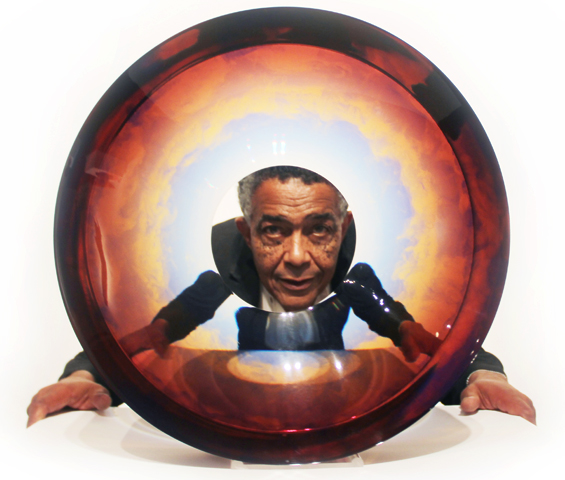Fred Eversley is an African American artist born in 1941. His path to becoming an artist, back in the early ’60s, is an unusual one. The son of a New York public school teacher and a aerospace engineer, he started his career with a degree in electrical engineering from the Carnegie Institute, and was accepted into the University of Pennsylvania School of Medicine, where he intended to study biomedical engineering. That summer, however, he traveled to Mexico to study photography and mural painting at the Instituto Allende, and when he returned to the states, he took a job as senior project engineer of Instrumentation Systems at Wyle Laboratories. There he supervised the design of the acoustic and vibration test laboratories for NASA, where they tested products used in both the Gemini and Apollo missions.

A view of Crystal Bridges’ lower pond through Fred Eversley’s Big Red Lens, 1985, cast polyester.
Crystal Briidges Museum of American Art, Bentonville, AR
In January of 1967, Eversley was in a serious car accident that left him on crutches for over a year. He retired from engineering and turned to making art full-time, beginning with photographs cast in polyester, and eventually eliminating the photos and working solely with translucent polyester and resin shapes.
In 1963 Eversley had taken up residence in Venice Beach in Los Angeles, primarily because it was the only LA beach community that would rent to Blacks. It was also populated with a number of artists of the “finish fetish” and “Light and Space” movements, including Larry Bell, Robert Irwin, Ed Moses, John Altoon, John McCracken, James Turrell, Richard Diebenkorn, and Charles Mattox, with whom Eversley shared a studio space when he changed his focus to art.
Throughout his career, Eversley was fascinated with energy. He had studied the parabola shape as a means to capture solar energy. As an artist, the shape continued to inspire him, but now as a means of capturing and transforming the movement of viewers of his work.

Fred Eversley’s Big Red Lens at Crystal Bridges Museum of American Art. photo by Bob Greenspan Photography
“The parabola is the perfect mathematical shape, in that it focuses all energy impinging on its concave front surface to a single perfect point in space,” he said. “This creates the only perfect fish eye lens, a 360-degree lens. I use the parabolic shape to create the making of kinetic art in a non-kinetic form through the natural movement of light and natural movement of people, the viewer moving and the light changing.”[1]
Eversley describes his technique for creating his work this way: “I invented the technique of centrifugally casting multiple layers of colored polyester resin into a cylindrical mold rotating around a horizontal axis. I cut the resulting cylinders into various shapes, which I then highly polished.” He began making small works, about three inches across. Then in 1970, he audaciously dropped in on Masha Tucker, then curator at the Whitney Museum in New York, and showed her his work. She was favorably impressed, even calling in colleagues from other departments to take a look. The next morning she called him to discuss mounting a solo show of his work and asked if he had work on hand.
“I totally fibbed. I said I had pieces in California,” Eversley replied. “I jumped on a plane that night and started making museum-scale pieces. In five months I managed to make pieces for the Whitney shows and another solo show which opened at week later at the Phyllis Kind Gallery in Chicago.”[2]
Since that first solo show, Eversley has been commissioned to produce 19 public artworks, and his work appears in the collections of museums around the world. In 1977 he was selected to be the first Artist in Residence at the Smithsonian’s Air and Space Museum.
Eversley’s idea of creating kinetic non-kinetic art can be seen and appreciated in his Big Red Lens, in Crystal Bridges’ collection. The shapes of people and of the work’s surroundings are naturally integrated into the work and become part of the viewer’s experience as they look at it, as evidenced by the number of visitor-produced images of the work that appear online.

Fred Eversley’s Big Red Lens at Crystal Bridges Museum of American Art. Image by CMonster
[1] Marilyn Holstein, “Meet the Master of the Lens.” Soho Life, November, 2012
[2] Holstein





